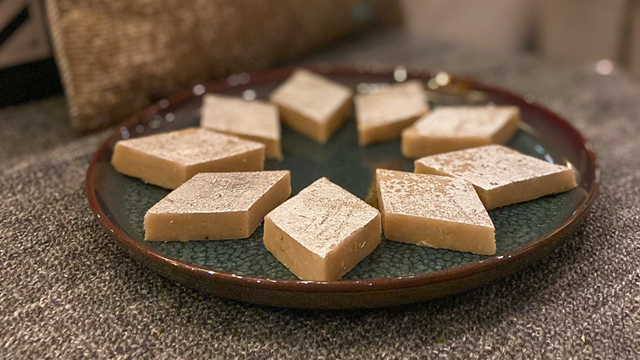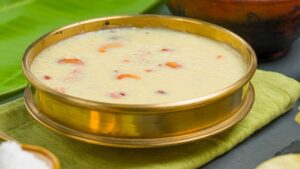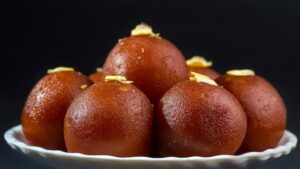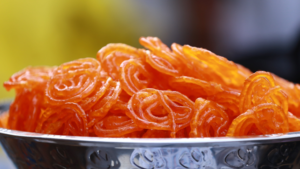Kaju Katli, also known as Kaju Barfi, is a popular and cherished Indian sweet made primarily from cashew nuts (known as “kaju” in Hindi) and sugar. It is a delicious, diamond-shaped dessert with a smooth, fudge-like texture and a rich taste.
Ingredients:
The traditional ingredients used to make Kaju Katli include:
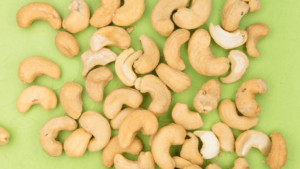
- Cashew Nuts (Kaju): Raw cashew nuts serve as the primary ingredient for Kaju Katli. They are finely ground into a powder or paste to form the base of this sweet.
- Sugar: Granulated sugar is used as a sweetening agent. It is combined with water to make a sugar syrup.
- Water: Used in the preparation of sugar syrup to achieve the desired consistency.
- Ghee (Clarified Butter): A small quantity of ghee may be added to the mixture for flavor and to prevent sticking. However, in traditional recipes, ghee might be omitted to keep the sweet vegan-friendly or for dietary preferences.
These basic ingredients are all that’s required to prepare the traditional version of Kaju Katli. However, there might be variations in some recipes, where additional ingredients such as saffron (for flavor and color), cardamom powder (for aroma and taste), or a small amount of milk might be added. However, the fundamental recipe usually sticks to the simplicity of cashew nuts, sugar, water, and occasionally, a small amount of ghee.
Preparation:
The preparation of Kaju Katli involves a few steps and careful attention to detail to achieve the perfect texture and taste. Here’s a typical method for making Kaju Katli:
Ingredients:
- 1 cup raw cashew nuts (kaju)
- 1/2 cup sugar
- 1/4 cup water
- 1 tablespoon ghee (clarified butter), optional
Instructions:
- Grind Cashew Nuts: Begin by grinding the raw cashew nuts into a fine powder using a food processor or grinder. Ensure the cashews are ground finely to achieve a smooth texture in the Kaju Katli.
- Prepare Sugar Syrup: In a pan, add sugar and water. Heat the mixture on low-medium heat, stirring continuously until the sugar dissolves completely.
- One-Thread Consistency: Once the sugar dissolves, continue to cook the syrup until it reaches a one-thread consistency. To test this, take a small amount of syrup between your thumb and index finger. When you separate your fingers, a single thread of syrup should form, indicating it has reached the desired consistency. Be cautious not to overcook and form a two-thread consistency, as it will make the Kaju Katli hard.
- Add Cashew Powder: Lower the heat and gradually add the ground cashew powder to the sugar syrup. Keep stirring continuously to avoid any lumps and ensure the mixture is well combined.
- Cook and Form Dough: Keep stirring the mixture on low heat until it thickens and forms a dough-like consistency. At this stage, you may add a tablespoon of ghee to the mixture to prevent sticking and for added flavor (optional).
- Rolling and Shaping: Once the mixture reaches a dough-like consistency, transfer it to a greased plate or parchment paper. Allow it to cool slightly until it’s comfortable to handle. Knead the dough gently to smoothen it. Place another greased parchment paper on top and use a rolling pin to roll the dough into a thin, even layer, about 1/4 inch thick.
- Cut into Diamond Shapes: Using a sharp knife, cut the rolled-out dough into diamond-shaped pieces. You can also use cookie cutters or a knife to cut them into desired shapes.
- Final Touch: Allow the cut pieces of Kaju Katli to cool completely. You can garnish each piece with a silver leaf (varak) for decoration (optional).
- Storage: Once completely cooled, store the Kaju Katli in an airtight container. They can be stored at room temperature for several days.
Following these steps carefully will help you achieve the traditional smooth and melt-in-your-mouth texture of Kaju Katli, making it a delightful treat to enjoy during festivals, celebrations, or as a sweet indulgence. Adjustments in ingredients or proportions can be made based on personal preferences or dietary needs.
Characteristics:
The characteristics of Kaju Katli contribute to its unique appeal and distinguish it as a popular Indian sweet. Here are its key characteristics:
- Texture: Kaju Katli has a distinctive texture that is smooth, soft, and slightly granular. It is firm yet melts in the mouth, leaving behind a rich and creamy sensation.
- Color: It typically boasts a pale creamy or light ivory color. The appearance might slightly vary based on the quality of cashew nuts used, but it generally maintains a light hue.
- Shape: Traditionally, Kaju Katli is cut into diamond-shaped or square pieces. The pieces are neatly shaped and often adorned with a silver leaf (varak) on top for decorative purposes.
- Flavor: It has a rich, nutty flavor derived from the cashew nuts. The sweetness from the sugar is well-balanced, allowing the natural taste of the cashews to shine through without being overwhelmingly sweet.
- Aroma: The aroma of Kaju Katli is subtly fragrant, with hints of roasted cashew nuts and the sweetness of sugar. Some recipes might incorporate additional flavors like cardamom or saffron for a more aromatic touch.
- Consistency: It possesses a balanced consistency that is neither too hard nor too soft. When properly made, it holds its shape well but easily breaks apart with a gentle bite.
- Presentation: Kaju Katli is often presented in a visually appealing manner, neatly cut into diamond or square shapes and arranged on plates or in boxes for gifting or serving during festive occasions.
- Shelf Life: When stored properly in an airtight container, Kaju Katli has a decent shelf life and can be enjoyed for several days, making it a convenient and long-lasting sweet.
These characteristic features, including its smooth texture, mild yet rich flavor, and elegant presentation, contribute to Kaju Katli’s popularity as a beloved Indian sweet enjoyed during festivals, celebrations, and special occasions, or simply as a delightful treat to savor.
Cultural Significance:
Kaju Katli holds significant cultural importance in Indian traditions, festivities, and social customs. Its cultural significance extends to various aspects:
- Festivals and Celebrations: Kaju Katli is a popular and integral part of Indian festivals and celebratory occasions. It is often prepared and shared during major festivals such as Diwali (the festival of lights), Raksha Bandhan (a festival celebrating the bond between brothers and sisters), weddings, engagements, and other auspicious events.
- Gifts and Exchanges: During festivals and special occasions, Kaju Katli is exchanged as a token of love, goodwill, and blessings among friends, family members, and relatives. It symbolizes sweetness, affection, and prosperity, making it a favored gift choice.
- Traditional Sweets Menu: Kaju Katli is a staple in the assortment of traditional Indian sweets (mithai) offered at sweet shops and households during celebrations. It holds a special place alongside other sweets like laddoos, barfis, and pedas.
- Cultural Values: Its preparation and sharing reinforce cultural values of togetherness, generosity, and hospitality. Offering Kaju Katli to guests, relatives, and friends during visits or gatherings is a gesture of warmth and hospitality deeply ingrained in Indian culture.
- Symbol of Good Fortune: In Hindu traditions, sweets like Kaju Katli are offered to deities during prayers and rituals as a symbol of auspiciousness and blessings. They are considered as offerings that invoke blessings for a prosperous and joyous life.
- Generational Heritage: The recipe for Kaju Katli is often passed down through generations, preserving culinary traditions and family recipes. Families may have their own unique methods and variations of making this sweet, keeping the cultural legacy alive.
- Regional Variations: Different regions of India might have their own versions or variations of Kaju Katli, incorporating local flavors or slight recipe modifications while preserving its essence.
- Emotional Connection: Kaju Katli is associated with nostalgia and cherished memories, evoking a sense of happiness and joy linked to festive celebrations and family gatherings.
Kaju Katli, with its delicious taste, cultural symbolism, and role in fostering social connections, holds a special place in Indian culture, making it more than just a sweet treat—it’s a representation of tradition, festivity, and shared joy.
Another information-
Here are some additional aspects and interesting information about Kaju Katli:
- Ingredients’ Role: The use of cashew nuts in Kaju Katli not only adds a rich flavor but also brings nutritional benefits. Cashew nuts are a good source of healthy fats, proteins, vitamins, and minerals like magnesium and phosphorus.
- Regional Names: While it’s commonly known as Kaju Katli in many parts of India, this sweet is also referred to as Kaju Barfi in some regions. “Barfi” or “Burfi” is a term used for Indian sweets with a fudge-like consistency.
- Versatility: Kaju Katli serves as a versatile dessert. Its mild yet distinctive taste allows it to pair well with various other sweets like pedas, ladoos, or even be used in dessert platters and combinations.
- Commercial Production: Apart from homemade versions, Kaju Katli is mass-produced and readily available in Indian sweet shops and markets. Several brands specialize in manufacturing and packaging this delicacy for wider distribution and consumption.
- Health Consciousness: With changing dietary preferences, there are now variations of Kaju Katli catering to health-conscious consumers. These might include sugar-free or reduced-sugar versions, catering to individuals with dietary restrictions or those aiming for healthier alternatives.
- Global Demand: Due to its delicious taste and cultural significance, Kaju Katli has gained popularity beyond India’s borders. It’s readily available in Indian grocery stores abroad and has become a sought-after treat among international audiences interested in exploring Indian sweets.
- Artisanal Craftsmanship: Making Kaju Katli requires skill and precision, especially in achieving the right consistency and texture. Skilled artisans and sweet makers take pride in creating perfectly shaped and textured Kaju Katli pieces, often using traditional techniques.
- Innovation in Presentation: In contemporary times, there have been innovations in the presentation and packaging of Kaju Katli, with variations in shapes, sizes, and decorative elements to appeal to modern tastes and aesthetics.
These points highlight the wide reach, adaptability, and evolving nature of Kaju Katli, showcasing its versatility, cultural relevance, and continued popularity among diverse audiences both in India and internationally.

